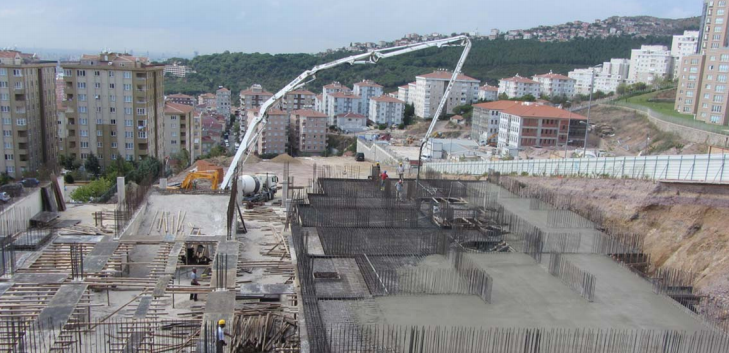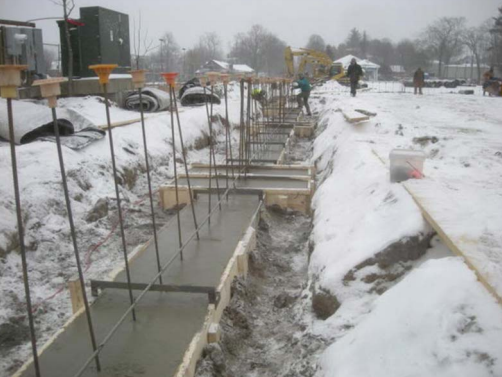Abstract
Concrete production and placement in hot air and cold water and the various problems that emerge in the concrete cure may affect the strength and durability of concrete adversely. In this article presented, various points to be considered and some actions that can be taken while pouring concrete in hot air and cold weather are outlined.
1. Introduction
In our country where many seasons occur the air temperature can vary widely according to the regions. For instance, while the average temperatures in North Dakota and Illinois are below zero during the winter months, significant temperature changes can be experienced between day and night. Nevada and Arizona are relatively warmer during the winter while temperatures are very high in summer. Air temperature is an important ambient condition that can affect concrete features and necessary precautions should be taken depending on weather conditions in concrete production, transportation, placement, and its cure. On the contrary case problems that may occur can affect the strength and durability of concrete adversely. Some suggestions for concrete pouring in hot air and cold weather are presented below.
2. Concrete Pouring in Hot Air
According to the operative America Standards in our country; the weather condition when the average temperature is above 86°F (30°C) for three consecutive days during concrete pouring is described as hot air. In the American Concrete Institute ACI 305[1], not only hot air but also high concrete temperature, low relative humidity, high wind speed, and sunlight, which may negatively affect the concrete features, are taken into account. Most of the problems which emerge in hot air are associated with the increase of the hydration rate of the cement and the evaporation rate of the water in the fresh concrete mixture. The heat generated depends on the cement composition and fineness, concrete composition, environment, and concrete temperature, and the use of substances. Depending on the hot air problems such as the increase in sinkage loss rate, the shortening of setting time, the possibility of increased plastic shrinkage in the freshly mixed concrete arise. Early curing of concrete becomes crucial in hot weather.
The precautions which the pragmatists can take against concrete pouring in hot air can be summed up like in the below;
- Even in the hottest regions, the nights are colder than the daytimes. It is beneficial to pour concrete in the evening or in the night times on hot and dry days.
- Concrete form and reinforcement must be dampened before the concrete pouring, as soon as the water of hydration vaporize pouring must be done.
- Features like sinkage, unit weight, and the air content of the concrete must be checked over with sufficient frequency throughout the production. The heat of the concrete comes out of the transit mixer, the heat during the process of placing concrete, the average temperatures during the protection of concrete with the lowest and the highest daily air temperatures must be measured and listed for the necessary evaluation.
- The heat of the concrete arrives at the worksite must be checked. In the situations where no action is taken to prevent negative effects the heat of the freshly mixed concrete must be lower than 95°F (35°C).
- A well-planned schedule is a must for placing concrete and surface coving operations. The concrete which arrives in the dumping ground must be placed without waiting and the vibration must be completed in a short period.
- Since early dehydration cause plastic shrinkage cracks in the concrete, the surface of the concrete must be covered with a damp cloth. Clothes should not be allowed to dry and must be dampened by spraying water. Thereby moisture loss from concrete would be prevented after pouring.
- It is a must to keep the concrete from direct sunlight as much as possible.
- The first surface finish is done right after pouring and placing the concrete.
- When someone is on the concrete if there is a few mm deep mark is formed the second surface finish may be done.
The heat of the hardening concrete which is placed in the mold and still hydrated should never go higher than 149°F (65°C) in any case.

The temperature difference between the point where the temperature of the concrete will be the highest in the building element at a certain moment (like the center of mass) and concrete cover layer depth and the temperature difference between the outer surface should not exceed 77°F (25°C) in reinforced concrete and 68°F (20°C) in unreinforced concrete in any case, necessary measures should be taken for this. Proper design of the concrete composition is required to meet the conditions. Besides from the precautions that pragmatist can take there are precautions which can be taken by the concrete producer. Since the heat of the freshly mixed concrete depends on the water makes the composition, cement and the heat of the aggregate, control of the temperatures in these materials is necessary and the following measures can be taken.
- The time between the production and the placement of concrete must be minimized. There should be clear communication between the concrete manufacturing facility and the worksite. Shipping must be tried to be carried out when urban traffic is not intense. If the speed of the concrete placing is low it can be tried to reduce the amount of concrete in the transit mixer and be considered to use the retarder.
- It can be useful to paint the drum of the agitator and the transit mixer to white and dampen its outside on its way out of the concrete plant. To prevent overheating the duration of mixing of concrete must be reduced.
- It should be taken care of that the heat of the mixing water which is used in the production of concrete not be high. The water must be kept in the tanks which have been already painted to white and conserved from solar ray’s direct effect.
- Using cement with lower heat of hydration and not increasing the dosage of cement would be beneficial.
- The temperature of the aggregate, which has the largest volume in concrete, should also be controlled. The temperature of the aggregate can be reduced by protecting it from the direct effects of sunlight or by spraying water.
- The replacement of some of the concrete water with aggregate-sized ice chips can also be considered as a precaution. The mixing time should be extended until all the ice in the concrete melts. Although adding ice to the concrete mix initially reduces the temperature of the concrete, after a while, the mixture temperature will reach the ambient temperature.
3. Concrete Pouring in Cold Weather
During concrete pouring; the average temperature falling below +5 ºC for three consecutive days is defined as cold weather in America Standards. In more than 3 consecutive days; If the average daily air temperature is less than 5 ºC or the temperature does not rise above 10 ºC in more than half of 24 hours, these conditions are also defined as cold weather conditions[2]. When the temperature of the environment where the concrete being poured decreases setting duration gets longer, hydration gets slower and the speed of gaining strength decreases therefore mold removal time is also delayed. And with the freshly mixed concrete and the water inside it freezing hydration stops. When the concrete which has been exposed to the frost effect starts to thaw hydration may begin again, however, adherence is greatly reduced at the interface between cement paste-aggregate and cement paste reinforcement. This situation makes the strength of concrete decrease.
Some precautions to be taken against concrete pouring in cold weather are the below;
- Concrete pouring should be avoided as much as possible in weather conditions like frost risk.
- Concrete forms must be checked before concrete pouring. Pouring shouldn’t be done to the icy surfaces of concrete form, if there are ice blocks they must be cleaned out.
- The placement temperature of concrete; must be higher than the limit value determined depending on the element cross-section and air temperature.
- The heat generated as a result of cement hydration should be prevented from spreading out of the concrete. For this, suitable insulation can be made on the outer surfaces of the molds. Open concrete surfaces should be insulated using suitable covers such as glass wool. In such a case it is possible to calculate the required insulation material thickness for efficient insulation.
- In cold weather, the construction can be heated to prevent a longer setting duration. On floors, the heating provided under the floor is at least as important as the heating above. It is possible to heat the concrete directly by using hot water and hot aggregate in the mixture, but this way isn’t effective as heating the construction, because many floors are far behind being thick enough to preserve its heat, they are very thin.
- The concrete must be conserved until it gets definite strength. This period varies according to the properties of the building element, the conditions to be exposed, and the concrete.

- As the rate of gaining concrete strength decreases, the molding period must be extended.
- Cement with high hydration heat, higher cement dosage, and low water/cement ratio can be selected.
- Hardening accelerator additives that reduce the freezing point of water can be used. The use of air-entraining additives is also beneficial.
- For the concrete’s initial temperature not to fall to the freezing point; aggregate, cement, and especially water can be heated. It would be beneficial to make the temperatures of these components identical during manufacture.
- It must be prevented the concrete to get cold during handling it.
4. Conclusion
During the concrete pouring in hot air or cold weather, problems may occur in obtaining the concrete properties as desired, depending on various disruptions. As summarized above, the most important step in concrete pouring under these conditions is the pre-pouring planning stage. With detailed planning and appropriate coordination of the concrete pouring stages, farsighted measures can be taken in advance against possible disruptions. It should not be forgotten that the temporary measures taken at the last moment have a low chance of success.
References
[1] ACI 305, “Hot Weather Concreting”, American Concrete Institute, 1999.
[2] ACI 306, “Cold Weather Concreting”, American Concrete Institute, 1997.
